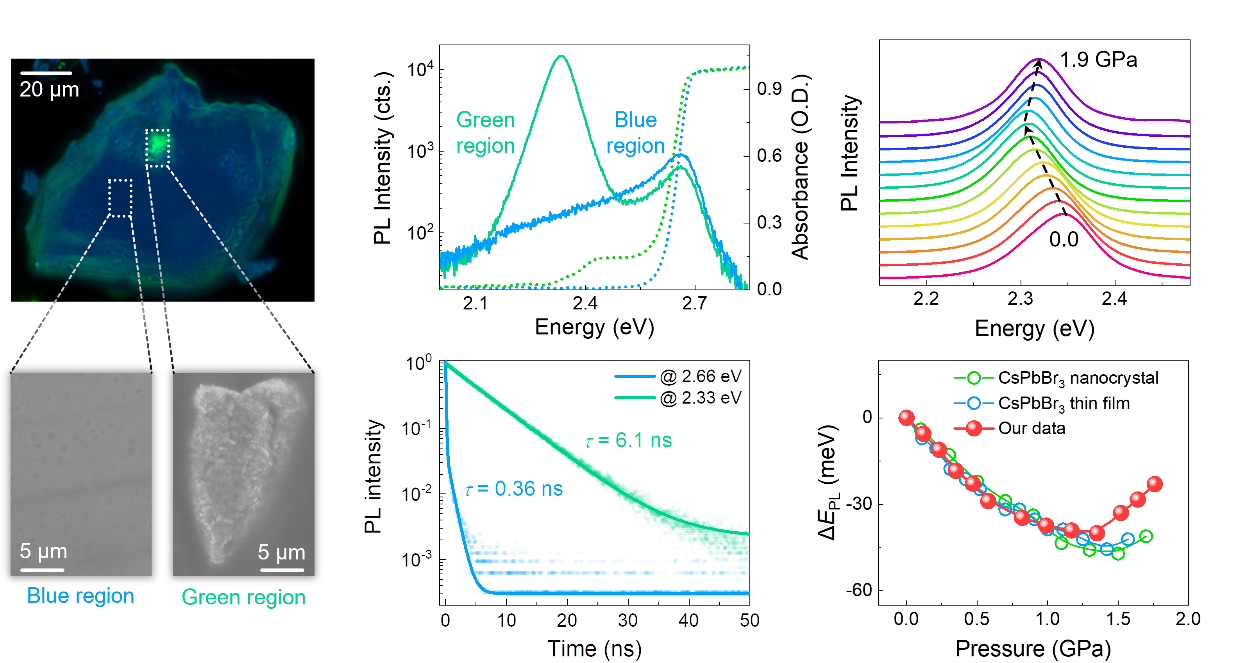Two-dimensional (2D) halide perovskites with diverse structures and properties have drawn increasing attention for promising optoelectronic applications. However, the previous reports of unusual dual emissions and two-edge absorption in Cs2Pb(SCN)2Br2 have generated intense debate on its origin and remained controversial. Recently, a research team led by Dr. Xujie Lü from the Center for High Pressure Science and Technology Advanced Research (HPSTAR), in collaboration with Prof. Lingling Mao from Southern University of Science and Technology, has successfully distinguish the observed dual emissions through high-pressure technology. They confirmed that the bule and green emissions come from Cs2Pb(SCN)2Br2 and CsPbBr3 nanocrystal, respectively. This research, titled “Pressure distinguishes the dual emissions in pseudohalide 2D Ruddlesden-Popper perovskite Cs2Pb(SCN)2Br2”, has recently been published in CCS Chemistry.
Compared with organic-inorganic hybrid 2D perovskites, all-inorganic compounds possess higher stability and potentially lower exciton binding energy Eb, which is favorable for carrier transport and promising for photovoltaic applications. "The conflicting messages about the source of the absorption and photoluminescence (PL) in Cs2Pb(SCN)2Br2 is a serious problem for further research and development of this material.," said Dr. Lü. "The distinct pressure responses of different compounds provide an avenue for distinguishing the dual emissions."

Caption: The dual emissions of 2D all-inorganic perovskite Cs2Pb(SCN)2Br2. The evolution of PL spectra for green emission in Cs2Pb(SCN)2Br2 under pressure shows exact same trend with that of CsPbBr3.
By comparing the high-pressure PL spectra, researchers confirmed that the bule and green emissions come from Cs2Pb(SCN)2Br2 and degraded CsPbBr3 nanocrystal respectively. "We obtained the real exciton binding energy of Cs2Pb(SCN)2Br2 (90 meV) by fitting the temperature-dependent intensity of the intrinsic blue emission," explained Dr. Songhao Guo, the leading author of the study. "The previous reported value of 160 meV is wrongly got from the extrinsic green emission." In addition, the PL intensity of Cs2Pb(SCN)2Br2 increased by 2.5 times under a mild pressure of 0.8 GPa, caused by the pressure-suppressed exciton-phonon interaction.
This work not only elucidates the origin of the dual emissions and two-edge absorption in Cs2Pb(SCN)2Br2, but also provides potential means to regulate and optimize the optoelectronic properties of 2D perovskites.
相较于有机-无机杂化体系,二维无机金属卤化物钙钛矿表现出更高的稳定性和独特的激子特性,使其在光伏器件中具有广阔的应用前景。近期,一种新型的二维无机钙钛矿Cs2Pb(SCN)2Br2在不同的报道中呈现出截然不同的发光特性,引发了研究人员的困惑并展开了热烈讨论。为解决此问题,北京高压科学研究中心(HPSTAR)吕旭杰研究员团队与南方科技大学毛陵玲等团队展开合作,基于不同组分在高压下的差异化演变行为,他们明确解析了该体系中双发射的内在机理,并通过压力抑制激子-声子相互作用,实现了光学性能的提升。相关成果以“Pressure distinguishes the dual emissions in pseudohalide 2D Ruddlesden-Popper perovskite Cs2Pb(SCN)2Br2”为题发表于近期的《CCS Chemistry》上。
